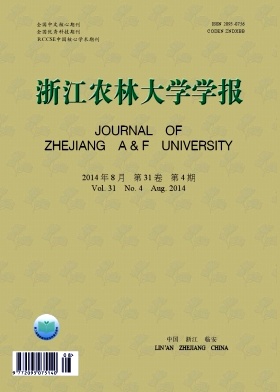-
藜麦Chenopodium quinoa又称南美藜、藜谷、奎奴亚藜等,是1年生的藜科Chenopodiaceae草本作物,在安第斯山脉种植已有5 000多年的历史,被印加人称为“谷物之母”和“安第斯山的真金”[1-2]。藜麦蛋白质含量高,具有近乎完美的氨基酸组成,富含不饱和脂肪酸、类黄酮、维生素E等多种有益化合物,是联合国粮农组织认定的唯一的完美营养食品,被誉为“未来的超级谷物”“营养黄金”“有机谷类之王”等[3-4]。长期食用藜麦,对心脏病、高血压、高血糖、高血脂等有很好防治作用。藜麦喜热带、亚热带干湿气候,生长温度为2.0~35.0 ℃,生长适温14.0~18.0 ℃,在营养生长阶段可耐轻度霜冻(-1.0~0 ℃),在种子结实之后可耐-6.0 ℃低温,对盐碱、干旱、霜冻、病虫害等的抗性能力都很强,植株在自然肥力低的情况下仍能生长良好[5]。由于藜麦的营养价值在提供粮食和营养安全等方面的突出作用,联合国大会宣布2013为“国际藜麦年”[6]。黄酮类化合物是一种生理活性活泼的物质,具有降低血管脆性及异常的通透性、降血压、降血脂及胆固醇、抗病毒、抗炎、抗癌防癌、抗氧化等药理作用,尤以对心脑血管疾病的治疗作用而备受重视[7-8]。研究者已用不同方法在银杏Ginkgo biloba[9],甘薯Ipomoea batatas[8],花生Arachis hypogaea[10],大蒜Allium sativum[11],荞麦Fagopyrum esculentum[12],小白菜Brassica rapa chinensis[13],金银花Lonicera japonica[14]以及豆科Leguminosae植物[15-16]中等进行了黄酮提取和含量测定。藜麦谷粒中比较丰富的类黄酮物质异黄酮和维生素E组合可明显促进糖、脂代谢和胰岛素分泌,对糖尿病的治疗作用明显[17-19]。然而,有关藜麦黄酮类化合物的研究国内外报道甚少[20]。本研究着重讨论藜麦叶片黄酮类物质的提取和测定方法,进而分析基因型间的差异,为藜麦叶片黄酮类物质的开发利用和高黄酮高氧化性资源的筛选提供依据。
HTML
-
藜麦盆栽40 d后,摘取新鲜叶片,于阴凉通风处晾干后,置于80 ℃鼓风烘箱中干燥12 h,取出后用粉碎机充分粉碎,过0.5 mm孔筛筛选,装入干燥器皿中备用。
-
主要试剂:芦丁对照品购自国药集团化学试剂有限公司;亚硝酸钠、硝酸铝、氢氧化钠、乙醇等试剂均为国产分析纯。
主要仪器:DHG 9123A电热恒温鼓风干燥箱(上海精宏实验设备有限公司)、TP?鄄214电子天平(丹佛仪器有限公司)、XMTD?鄄6000恒温水浴锅(上海申胜生物技术有限公司)、TDL?鄄40B台式离心机(上海安亭科学仪器厂)、752PC紫外可见分光光度计(上海光谱仪器有限公司)。
-
以藜麦品种PI814932为材料,精确称取其全粉1.00 g,置于圆底烧瓶中。采用水浴回流加热法进行提取试验。选择影响藜麦叶片黄酮得率的主要因素如乙醇体积分数、料液比、浸提时间等3个因素为考察因子,按照L9(33)正交表安排不同提取条件试验(表 1),以确定最佳提取条件。
试验编号 乙醇体积分数(A)/%( 时间(B) /h 料液比(C) 总黄酮得率/% 1 30 0.5 1:80 0.499 2 30 1.0 1:40 0.594 3 30 1.5 1:60 0.411 4 70 0.5 1:40 0.936 5 70 1.0 1:60 0.733 6 70 1.5 1:80 0.476 7 95 0.5 1:60 0.877 8 95 1.0 1:80 0.625 9 95 1.5 1:40 0.501 K1 1.504 0 2.312 0 2.031 0 K2 2.145 0 1.952 0 2.021 0 K3 2.003 0 1.388 0 1.600 0 Rj 0.214 0 0.308 0 0.144 0 说明: K为第"j"列因素3水平所对应的试验指标和; Rj为第"j"列因素的极差。 Table 1. Orthogonal table L9(33) and experimental results
-
鉴于目前以芦丁为标样的比色法是测定黄酮得率最常用的方法[21],本研究仍沿用该法来测定藜麦总黄酮得率。准确称取芦丁标准试剂5.000 mg,用体积分数为60%乙醇完全溶解后定容至50.0 mL,摇匀的质量浓度为0.1 g·L-1的芦丁标准溶液。分别吸取芦丁标准溶液0.0,1.0,2.0,3.0,4.0,5.0 mL于6只10.0 mL刻度试管中,用体积分数为60%乙醇补至5.0 mL,加入质量分数为5%的亚硝酸钠溶液0.3 mL,摇匀,放置6 min后加入质量分数为10%的硝酸铝溶液0.3 mL,放置6 min,再加入1.0 mol·L-1氢氧化钠溶液4.0 mL,混匀,再加体积分数为60%的乙醇0.4 mL,室温放置15 min后于波长501 nm处测定其吸光度,以体积分数为60%乙醇溶液为空白对照,建立测定标准曲线和线性回归方程。测定时,以不同的样品液代替芦丁标准溶液,其他步骤与制作芦丁标准方程相同。计算公式如下:总黄酮得率(%)=(C×V1×V2×10-3)/(W/V0)×100。其中:C为测定样液的质量浓度(g·L-1);V0为测定吸光度所用样液的体积(mL);V1为测定时稀释体积(mL);V2为样液定容后体积(mL);W为样品质量(g)。
-
精确称取藜麦品种‘TEMUCO Quinoa TRADITIONAL’共6份相同样品,按上述最佳提取和测定方法进行重复性试验,验证可靠性。选上述藜麦品种‘TEMUCO Quinoa TRADITIONAL’,设定不同加入量,6次重复,加入已知量芦丁样液,计算回收率,黄酮提取和测定方法同上。
-
选择‘TEMUCO Quinoa TRADITIONAL’‘QuinoaB.Rain Sow’‘Temuco’‘1591 Quinoa Cherry’‘Tomico Quinoa’‘CQ?鄄TEMVCC’‘PI814932’‘PI596293’‘Tumuco(7)hybrids’‘PsI596498’10个不同基因型藜麦品种,统一播种和管理,采用上述同样方法进行制样。然后采用确定的最优提取工艺,对所选藜麦品种进行提取,分析藜麦叶片黄酮得率的基因型差异。
1.1. 材料
1.2. 试剂及仪器
1.3. 藜麦类黄酮的提取
1.4. 藜麦总黄酮量的测定
1.5. 藜麦重复性试验及其加样回收率试验
1.6. 藜麦黄酮得率的基因型差异
-
芦丁在0~50.0 mg·L-1质量浓度范围内,以吸光值(y)为纵坐标,芦丁标准品质量浓度(x)为横坐标,绘制标准曲线,得到回归方程:y=13.771x-0.013 6(R2=0.998 0)。该结果表明:芦丁在该质量浓度范围内吸光度值与质量浓度之间存在良好的线性关系。
-
选用30%,70%和95% 3个有代表性的乙醇体积分数作为提取液。因乙醇沸点在80 ℃左右,采用水浴热回流法(80~90 ℃)提取对它影响很小,因此,温度因素可不考虑在内。其他提取条件为提取时间和料液比。利用3因子3水平正交试验研究各因素对工艺的影响,同时为明确影响提取得率的显著性因子,对正交表中的黄酮得率作方差分析。结果分别见表 1和表 2。
方差来源 平方和(S) 自由度(f) 均方(s/f) F值 临界值 乙醇体积分数(A) 0.075 5 2 0.037 8 6.51 F0.05(2,2)=19 时间(B) 0.144 6 2 0.072 3 12.47 F0.1(2,2)=9 料液比(C) 0.040 3 2 0.020 2 3.47 F0.2(2,2)=4 误差 0.011 6 2 0.005 8 总和 0.272 0 8 Table 2. Variation analysis of extraction rate of flavonoids in quinoa
由表 2可知:FB>F0.1,因素B对黄酮提取量的影响显著,F0.2<FA<F0.1,因素A对黄酮提取量有一定的影响,但不显著。由表 1可知,RB>RA>RC,据此,可确定各因素对黄酮提取量影响主次顺序为B>A>C。
-
由表 1可知:提取时间为0.5 h时黄酮得率最高,其后逐渐降低。因此,提取时间以0.5 h为佳。延长浸提时间,可能由于黄酮降解,从而降低了提取量[8]。
-
由表 2可知:乙醇休积分数对指标具有一定的影响。根据表 1和因素A的数据,乙醇体积分数为30%~70%时,黄酮得率剧增;而乙醇体积分数为70%~95%时,黄酮得率明显下降,显现一个抛物线变化的趋势。因此,确定乙醇最佳体积分数为70%。
-
由表 2可知:料液比对指标影响不显著。当对不同料液比进行试验时,发现料液比在1:40时,黄酮?鄄得率略高于料液比为1:60,其后随着料液比的增加黄酮?鄄得率逐渐降低。因此,从节约材料与药品综合比较后,确定最适料液比为1:40。
综上所述,藜麦总黄酮得率的最优提取条件为:乙醇体积分数70%,浸泡时间0.5 h,料液比1:40。
-
根据已获得的芦丁标准曲线与线性回归方程,计算出每毫升提取液中的总黄酮含量,再根据公式计算总黄酮得率。为验证比色法测定黄酮得率的可靠性,进行了6次重复性试验和回收率试验。实验结果显示:在波长510 nm条件下,各重复实验组的吸光度值分别为0.638,0.637,0.635,0.637,0.634,0.639。结果证明了比色法测定的可靠性;从回收率结果(表 3)可以看出,本测定方法各处理的回收率均接近100%,重现性也较高。综合上述,本法适用于测定藜麦黄酮类化合物的得率。
试验编号 样品中含量/mg 加入芦丁量/mg 测得量/mg 回收率/% 平均回收率/% 相对标准偏差/% 1 7.134 0.100 7.441 102.86 100.25 4.22 2 14.268 0.100 13.415 93.37 3 7.039 0.100 7.441 104.23 4 14.078 0.100 14.265 100.61 5 7.998 0.100 8.368 103.33 6 15.996 0.100 15.630 97.10 Table 3. Experimental results of recovery in extraction rate of flavonoids in quinoa
-
表 4列出了10个藜麦品种的黄酮得率。由表 4可知:藜麦黄酮得率在基因型间存在很大差异,变幅为0.215%~0.933%,平均为0.619%,变异系数达34.44%。其中,以品种‘PI814932’的总黄酮得率最高,达0.933%。其次为‘QuinoaB. Rain Sow’和‘Temuco’,分别列第2位和3位,但两者基因型黄酮得率差异不大。紧随其后的分别是品种‘1591 Quinoa Cherry’和‘TEMUCO Quinoa TRADITIONAL’。品种‘Tomico Quinoa’和‘CQ?鄄TEMVCC’的基因型黄酮得率相近,分别排列第8位和第9位。而叶片表面覆有紫色粉层的‘PI596498’品种的总黄酮得率最低,为0.215%,藜麦总黄酮得率可能与其叶片表面的紫色粉层有关。
品种 叶表情况 叶形状 总黄酮得率/% TEMUCO Quinoa TRADITIONAL 绿色 提琴形锯齿状 0.635 QuinoaB.Rain Sow 绿色 提琴形锯齿状 0.818 Temuco 绿色 提琴形锯齿状 0.805 1591 Quinoa Cherry 绿色 提琴形锯齿状 0.751 Tomico Quinoa 绿色 提琴形锯齿状 0.472 CQ-TEMVCC 绿色 提琴形锯齿状 0.477 PI814932 绿色 提琴形锯齿状 0.933 PI596293 绿色 提琴形锯齿状 0.512 Tumuco(7)hybrids 绿色 提琴形锯齿状 0.572 PI596498 绿色(表面覆有紫色粉层) 卵形略有锯齿 0.215 平均值 0.619 变异系数/% 34.44 Table 4. Genotype variation of extraction yields of flavonoids in quinoa
2.1. 芦丁标准曲线的确定
2.2. 最佳提取条件的确定
2.2.1. 浸提时间的选择
2.2.2. 乙醇体积分数的选择
2.2.3. 料液比的选择
2.3. 藜麦总黄酮得率的测定方法
2.4. 藜麦黄酮得率的基因型差异分析
-
黄酮类化合物因其独特的保健功能而越来越得到人们的重视[8]。藜麦被认为是最适宜人类的完美“全营养食品”,是最具潜力的农作物之一。藜麦种子及新芽中的花青素、总多酚有较高的抗氧化性,可以作为传统食物的替代品,具有很高的营养价值[22]。藜麦的叶子可当蔬菜吃,与菠菜Spinacia oleracea叶子相似,既可用来凉拌生食,又是新鲜蔬菜的色拉的理想原料。本研究首次对藜麦的不同基因型品种的叶片黄酮得率进行了测定比较。参照国内外提取黄酮的多种方法[23-24],紫外可见分光光度法操作■简单方便,标准对照品易得,结果可靠,是黄酮类化合物的定量分子最常用的方法之一[25]。本着溶剂无毒性、易回收、对黄酮溶解力强和工艺简单的原则,确定乙醇为最佳提取剂。本研究表明,藜麦黄酮类化合物的提取率与乙醇体积分数、提取时间和料液比有关。经采用3因素3水平正交试验,其最佳提取工艺是乙醇体积分数70%,提取时间0.5 h,料液比1:40,且一次提取即可使得率达85%以上,这为藜麦黄酮类化合物的开发利用提供了理论依据和工艺参数。
黄酮得率的比色法测定比较简单可靠,但易受脂类物质的干扰[8]。从重复性试验和回收率试验中可看出,比色法适于测定藜麦总黄酮得率,且具有良好的重现性和稳定性。说明藜麦叶片中含脂量不足以影响藜麦黄酮的提取和测定。研究表明:‘PI814932’品种的黄酮提取量最高,达0.933%,该含量高于赪桐Clerodendrum japonicum根[24], 鲜青蒿Artemisia carvifolia[26], 甜菜Beta vulgaris[27]等的黄酮含量。不同品种间藜麦叶片黄酮得率差异系数达34.44%,说明通过适当的育种改良途径和方法,可以筛选到高黄酮高抗氧化性藜麦品种。藜麦黄酮提取量还可能受叶片粉质层的成分、叶片中叶绿素、花青苷、类胡萝卜素含量[28]以及内酯含量大小的遗传和环境因子[29]等因素影响。本项目将对不同生长发育时期的藜麦叶片黄酮含量变化,以及叶片和种子黄酮含量的相关性作进一步研究,更好地促进藜麦作为一种保健的多功能多方面可利用的食物源的大力开发。






 DownLoad:
DownLoad: